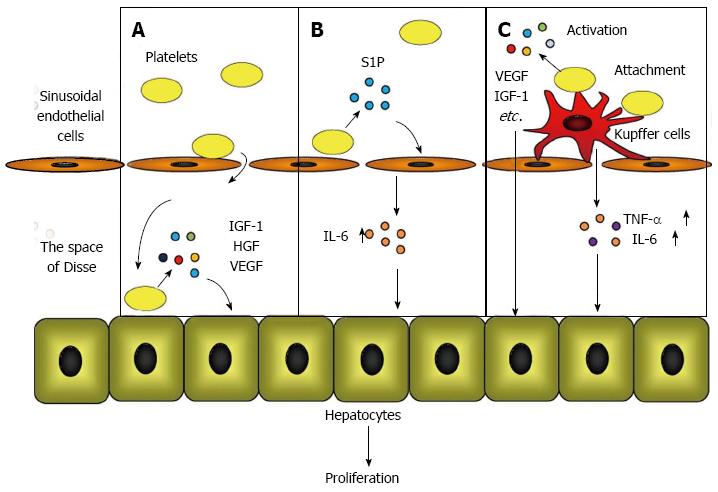Copyright
©2013 Baishideng Publishing Group Co.
World J Surg Proced. Nov 28, 2013; 3(3): 29-36
Published online Nov 28, 2013. doi: 10.5412/wjsp.v3.i3.29
Published online Nov 28, 2013. doi: 10.5412/wjsp.v3.i3.29
Figure 1 Platelet-mediated liver regeneration.
Platelets accumulate in the liver immediately after a hepatectomy. A: Platelets translocate into the space of Disse and release insulin-like growth factor (IGF)-1, hepatocyte growth factor (HGF), and vascular endothelial growth factor (VEGF) by directly contacting hepatocytes; B: Direct contact of platelets with liver sinusoidal endothelial cells induces the release of S1P from platelets and the secretion of interleukin-6 (IL-6) from liver sinusoidal endothelial cells; C: Kupffer cells activated in response to a hepatectomy induce the accumulation and activation of platelets. Growth factors released from platelets and the enhanced release of tumor necrosis factor-α (TNF-α) and IL-6 from Kupffer cells promote liver regeneration.
Figure 2 Platelet-mediated inhibition of fibrosis.
Platelets release adenosine nucleotides, which are degraded to adenosine by enzymes located on the plasma membrane of hepatic stellate cells. The activation of hepatic stellate cells is directly suppressed by the adenosine-cAMP signaling pathway.
Figure 3 Platelet-mediated inhibition of apoptosis.
Platelets activate the Akt pathway and up-regulate Bcl-xL, which suppresses caspase-3 activation to prevent hepatocyte apoptosis.
- Citation: Takahashi K, Murata S, Ohkohchi N. Platelet therapy: A novel strategy for liver regeneration, anti-fibrosis, and anti-apoptosis. World J Surg Proced 2013; 3(3): 29-36
- URL: https://www.wjgnet.com/2219-2832/full/v3/i3/29.htm
- DOI: https://dx.doi.org/10.5412/wjsp.v3.i3.29















